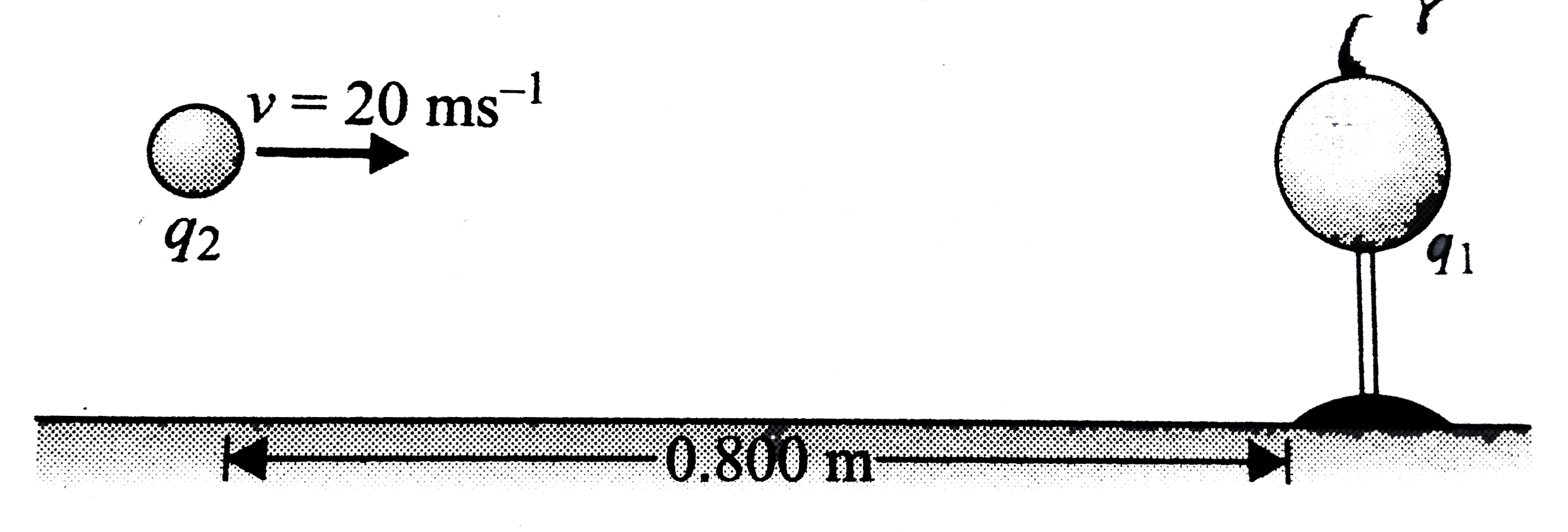A small metal sphere, carrying a net charge q1=−2μC, is held in a stationary position by insulating supports. A second small metal sphere, with a net charge of q2=−8μC and mass 1.50g, is projected toward q1. When the two spheres are 0.800m apart, q2 is moving toward q1 with speed 20ms−1 as shown in (Fig. 3.151). Assume that the two spheres can be treated as point charges. You can ignore the force of gravity.
 .
.
The speed of q2 when the spheres are 0.400m apart is.
2√10ms−1
2√6ms−1
4√10ms−1
4√6ms−1
The correct Answer is:C
Ei=Ki+Ui=12(0.0015kg)(20.0ms−1)2+k(2.00×10−6C)(8.00×10−6C)0.800m
=0.48J
Ei=Ef=12mv2f+kq1q2rf
vf=√2(0.48J−0.3t6J)0.0015kg=4√10ms−1
At the closest point, the velocity is zero.
0.48J=kq1q2r
or r=k(2.00×10−6C)(8.00×10−6C)0.48J=0.30m.
Topper's Solved these Questions
- ELECTRIC POTENTIALBOOK - CENGAGE PHYSICS ENGLISHCHAPTER - ELECTRIC POTENTIALEXERCISE - Integer
5 Videos
- ELECTRIC POTENTIALBOOK - CENGAGE PHYSICS ENGLISHCHAPTER - ELECTRIC POTENTIALEXERCISE - DPP 3.1
14 Videos
- ELECTRIC POTENTIALBOOK - CENGAGE PHYSICS ENGLISHCHAPTER - ELECTRIC POTENTIALEXERCISE - Multiple Correct
10 Videos
- ELECTRIC FLUX AND GAUSS LAWBOOK - CENGAGE PHYSICS ENGLISHCHAPTER - ELECTRIC FLUX AND GAUSS LAWEXERCISE - MCQ s
38 Videos
- ELECTRICAL MEASURING INSTRUMENTSBOOK - CENGAGE PHYSICS ENGLISHCHAPTER - ELECTRICAL MEASURING INSTRUMENTSEXERCISE - M.C.Q
2 Videos
Similar Questions
A small metal sphere, carrying a net charge q1=−2μC, is held in a stationary position by insulating supports. A second small metal sphere, with a net charge of q2=−8μC and mass 1.50g, is projected toward q1. When the two spheres are 0.800m apart, q2 is moving toward q1 with speed 20ms−1 as shown in (Fig. 3.151). Assume that the two spheres can be treated as point charges. You can ignore the force of gravity.
 .
.
How close does q2 get to q1 ?
View SolutionA positive point charge q is brought near a neutral metal sphere.
View Solution
Knowledge Check
Metallic sphere of radius R is charged to potential V. Then charge q is proportional to
AVBRCboth V and RDnone of these
A point charge q1=−1.0μC is held stationary at the origin. A second point charge q2=+2.0μC moves from the point (1.0m,0,0) to (2.0m,0,0). How much work is done by the electric force on q2?
View SolutionA point charge q1=−5.8μC is held stationary at the origin. A second point charge q2=+4.3μC moves from the pont (0.26m0,0) to (0.38m,0,0). How much work is done by the electric force on q2?
View SolutionA point charge q1=−5.8μC is held stationary at the origin. A second point charge q2=+4.3μC moves from the point (0.26m0,0) to (0.38m,0,0). How much work is done by the electric force on q2?
View SolutionAn isolated conduction sphere sphere whose radius R=1 m has a charge q=19nC. The energy density at the surfasce of the sphere is
View SolutionThe insulated spheres of radii R1 and R2 having charges Q1 and Q2 respectively are connected to each other. There is
View SolutionThe insulated spheres of radii R1 and R2 having charges Q1 and Q2 respectively are connected to each other. There is
View SolutionTwo spherical conductors of radii R1andR2 are separated by a distance much larger than the radius of eighter sphere. The spheres are connected by a conducting wire as shown in (Fig. 3.128). If the charges on the spheres in equilibrium are q1andq2, respectively, what is the ratio of the field strength at the surfaces of the spheres ?
 .
.
View Solution
